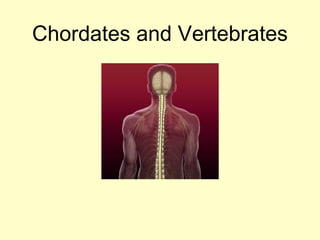Chordates and vertebrates
•Download as PPT, PDF•
10 likes•4,309 views
Here are definitions of the key terms: Chordate - An animal belonging to the phylum Chordata, which includes all animals with a notochord or backbone at some stage of their lives. Notochord - A flexible rod of cells that forms the basic structure along the back in early embryonic chordates. It is replaced by the vertebral column in most vertebrates. Postanal tail - The muscular structure behind the anus that is present in early chordate embryos. Nerve cord - A tube-like structure above the notochord that develops into the central nervous system. Pharyngeal pouch - Sac-like projections in the throat region that filter feed in some
Report
Share
Report
Share

Recommended
Recommended
More Related Content
What's hot
What's hot (20)
Viewers also liked
Viewers also liked (20)
Similar to Chordates and vertebrates
Similar to Chordates and vertebrates (20)
Origen and classification of veretebrates 2017 new microsoft powerpoint prese...

Origen and classification of veretebrates 2017 new microsoft powerpoint prese...
Briefly discuss the adaptive changes seen in the chordates over the o.pdf

Briefly discuss the adaptive changes seen in the chordates over the o.pdf
Chapter 14 & 15- fish, anphibians, reptiles, birds, mammals

Chapter 14 & 15- fish, anphibians, reptiles, birds, mammals
More from CDA-PamelaOrtiz
More from CDA-PamelaOrtiz (20)
Recently uploaded
https://app.box.com/s/4hfk1xwgxnova7f4dm37birdzflj806wGIÁO ÁN DẠY THÊM (KẾ HOẠCH BÀI BUỔI 2) - TIẾNG ANH 8 GLOBAL SUCCESS (2 CỘT) N...

GIÁO ÁN DẠY THÊM (KẾ HOẠCH BÀI BUỔI 2) - TIẾNG ANH 8 GLOBAL SUCCESS (2 CỘT) N...Nguyen Thanh Tu Collection
Recently uploaded (20)
Home assignment II on Spectroscopy 2024 Answers.pdf

Home assignment II on Spectroscopy 2024 Answers.pdf
Basic Civil Engineering Notes of Chapter-6, Topic- Ecosystem, Biodiversity G...

Basic Civil Engineering Notes of Chapter-6, Topic- Ecosystem, Biodiversity G...
GIÁO ÁN DẠY THÊM (KẾ HOẠCH BÀI BUỔI 2) - TIẾNG ANH 8 GLOBAL SUCCESS (2 CỘT) N...

GIÁO ÁN DẠY THÊM (KẾ HOẠCH BÀI BUỔI 2) - TIẾNG ANH 8 GLOBAL SUCCESS (2 CỘT) N...
2024.06.01 Introducing a competency framework for languag learning materials ...

2024.06.01 Introducing a competency framework for languag learning materials ...
Digital Tools and AI for Teaching Learning and Research

Digital Tools and AI for Teaching Learning and Research
Sectors of the Indian Economy - Class 10 Study Notes pdf

Sectors of the Indian Economy - Class 10 Study Notes pdf
Solid waste management & Types of Basic civil Engineering notes by DJ Sir.pptx

Solid waste management & Types of Basic civil Engineering notes by DJ Sir.pptx
TESDA TM1 REVIEWER FOR NATIONAL ASSESSMENT WRITTEN AND ORAL QUESTIONS WITH A...

TESDA TM1 REVIEWER FOR NATIONAL ASSESSMENT WRITTEN AND ORAL QUESTIONS WITH A...
aaaaaaaaaaaaaaaaaaaaaaaaaaaaaaaaaaaaaaaaaaaaaaaaaaaaaaa

aaaaaaaaaaaaaaaaaaaaaaaaaaaaaaaaaaaaaaaaaaaaaaaaaaaaaaa
Students, digital devices and success - Andreas Schleicher - 27 May 2024..pptx

Students, digital devices and success - Andreas Schleicher - 27 May 2024..pptx
Chordates and vertebrates
- 2. Introduction to Chordates Chordates are animals that have four structures present at some stage of their development. postanal tail pharyngeal pouches or “gill slits” nerve cord notochord cat embryo at 2 weeks Animals in this group include tunicates, lancets, fish, amphibians, reptiles, birds, and mammals.
- 3. All vertebrate embryos look very similar too each other because they are all chordates. Note that all of these chordates have: a notochord, postanal tail, nerve cord, and pharyngeal pouches.
- 4. Notochord All chordates have an internal notochord that supports the animal and extends along the upper part of the body (what we think of as the back. - The notochord is a firm but flexible structure made up of fluid- filled cells that are enclosed in a stiff covering. - The notochord extends into the postanal tail which is a muscular structure at the end of the developing chordate. - In most chordates (fish, amphibians, reptiles, birds and mammals) the notochord gets replaced by the back bones or vertebrae - Other chordates such as the tunicate and the lancet, the notochord is kept into adulthood.
- 5. Tunicates and Lancets Lancets a.k.a. amphioxus are primitive eel-like chordates that spend most Tunicates a.k.a. sea squirts are of their time buried in sand. sessile marine chordates. They contain typical As larvae they are free chordate features. swimming and contain Both tunicates and lancets notochord, nerve cord, and other chordate features. are invertebrates.
- 6. Nerve Cord Above the notochord is a tube-like structure called the nerve cord. - As most chordates develop, the nerve cord enlarges and becomes the central nervous system. - The front end of the nerve cord enlarges and becomes the brain. nerve cord - The remainder of the nerve nerve cord cord becomes the spinal cord.
- 7. Pharyngeal Pouches Pharyngeal pouches are sac-like projections found in the region between the mouth and digestive tube. - Many chordates have several pairs of pharyngeal pouches. - Ancient invertebrate chordates such as tunicates and lancets use them for filter feeding. - In fish pharyngeal pouches become gills Pharyngeal - In humans pharyngeal pouches pouches are present only during embryonic development.
- 8. Vertebrates Vertebrates make up the largest group of animals in the chordate phylum. They include jawless fish, jawed cartilaginous fish, bony fish, amphibians, reptiles, birds, and mammals. Vertebrates contain all chordate characteristics plus … - endoskeleton made up of bones and cartilage - backbones (vertebrae) that protects the spinal cord - skull that protects the brain Because vertebrates are animals, they also have all the characteristics of animals that we learned earlier.
- 9. Ectotherms and Endotherms Vertebrates can be divided as ectotherms (cold-blooded) or as endotherms (warm-blooded). Ectotherms include Endotherms include fish, amphibians, and birds and mammals. reptiles. - Their internal body - Their core body temperature changes temperature is kept with the temperature of nearly constant its surroundings. through thermal homeostasis.
- 10. Origin of Chordates Chordates are believed to have descended from echinoderm-like ancestors during the Precambrian period.
- 11. Homework Define the words: chordate, notochord, postanal tail, nerve cord, pharyngeal pouch, endoskeleton, cartilage, vertebrae, ectotherm, endotherm